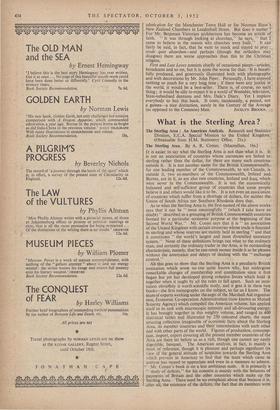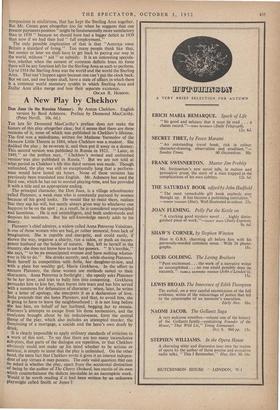What is the Sterling Area ?
The Sterling Area : An American Analysis. Research and Statistics Division, E.C.A. Special Mission to the United Kingdom. (Obtainable from H.M. Stationery Office. 21s.) The Sterling Area. By A. R. Conan. (Macmillan. 16s.) IT is easier to say what the Sterling Area is not than what it is. It is not an association of countries whose currencies are linked to sterling rather than the dollar, for there are many such countries outside it. It is not another name for the British Commonwealth, for one leading member of the Commonwealth, to wit, Canada, is outside it, two ex-members of the Commonwealth, Ireland and Burma, are in it, as are also two countries, Iceland and Iraq, which were never in the Commonwealth.. It is not the economically balanced and self-sufficient group of countries that some people believe it and others would like it to be. It is not even an association of countries which suffer from a shortage of dollars, for neither the Uni6n of South Africa nor Southern Rhodesia does that.
As to what the Sterling Area is, the first-named of the above works says that it can be " most meaningfully " (which I take leave to doubt) " described as a grouping of British Commonwealth countries formed for a particular economic purpose at the beginning of the Second World War." Mr. Conan says that it is " an association of the United Kingdom with certain countries whose trade is financed in sterling and whose reserves are mainly held in sterling " and that it constitutes " the world's largest and most diversified monetary system." None of these definitions brings out what to the ordinary man, and certainly the ordinary trader in theArea, is its outstanding characteristic, namely, that he can remit money inside it as he pleases without the annoyance and delays of dealing with the " exchange control."
All this goes to show that the Sterling Area is a peculiarly British institution which arose no one quite knows why, has undergone remarkable changes of membership and constitution since it first began but yet has developed strong cohesive forces which hold it together when it ought by all the rules to fall apart. Such an insti- tution obviotisly is worth scientific study, and it gets it in these two books—the first monographs on the subject, so far as 1 know. The team of experts.working under the aegis of the Marshall Aid organisa- tion, Economic Co-operation Administration (now known as Mutual Security Agency) which compiled the American volume, has applied itself to its task with microscopic intensity and all-devouring energy. It has brought together in this weighty volume, and ranged in 400 statistical tables and illustrated by 250 coloured charts, the most amazing collection imaginable of economic facts about the Sterling Area, its member countries and their interrelations with each other and with other parts of the world. Figures of production, consump- tion, import, export covering all the present member countries of the Arca are there set before us as a rich, though one cannot say easily digestible, banquet. The American analysis, in fact, is mainly a book of reference, though it is pleasant and perhaps significant (in view of the general attitude of suspicion towards the Sterling Area which prevails in America) to find that the team which came to analyse has stayed to appreciate and- even in a measure to admire.
Mr. Conan's book is on a less ambitious scale. It is primarily a " study of deficits," for his concern is mainly with the balances of payments of Britain and the other countries which make up the Sterling Area. There need be no complaint about that because it is, after all, the existence of the deficits, the fact that its members were companions in misfortune, that has kept the Sterling Area together. But Mr. Conan goes altogether too far when he suggests that our present payments position ' `might be fundamentally more satisfactory than in 1939 " because we should have had a bigger deficit in 1939 than now if we had then had " full employment."
The only possible implication of that is that "America owes Britain a standard of living." Too many people think like that, but sooner or later we shall have to get back to paying our way in the world, without " aid " or subsidy. It is an interesting specula- tion_whether when the cement of common deficits loses its force there will be any function left for the Sterling Area as such to perform. Up to 1914 the Sterling Area was the world and the world the Sterling Area. That can't happen again because one can't put the clock back. But we can, and one hopes shall, have a state of affairs in which there is a common world monetary system in which Sterling Area and Dollar Area alike merge and lose their separate existence.
OSCAR R. HOBSON.



















































 Previous page
Previous page